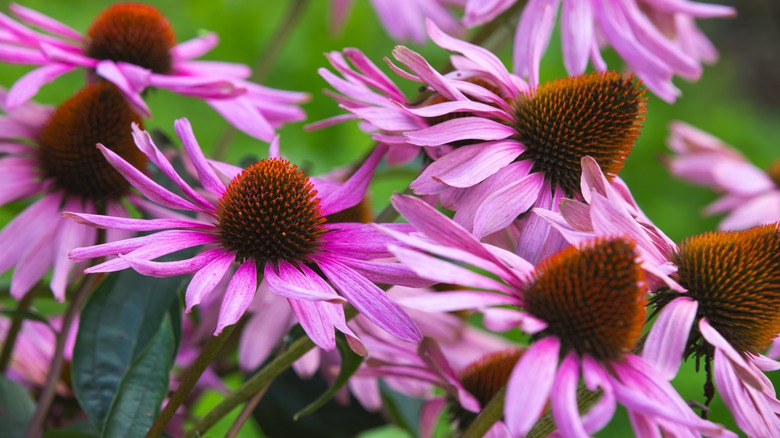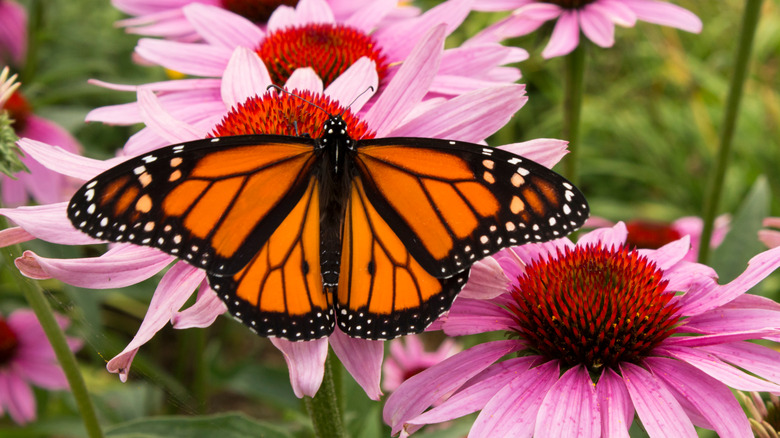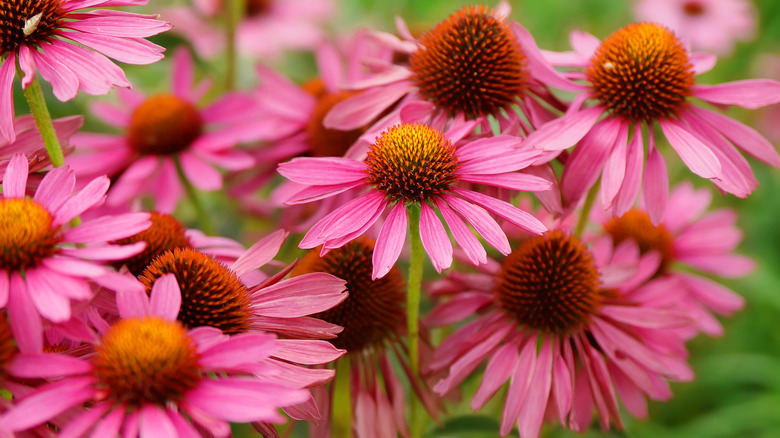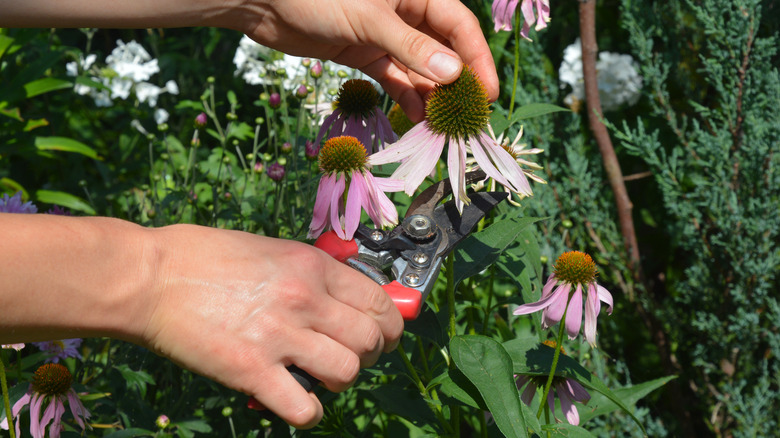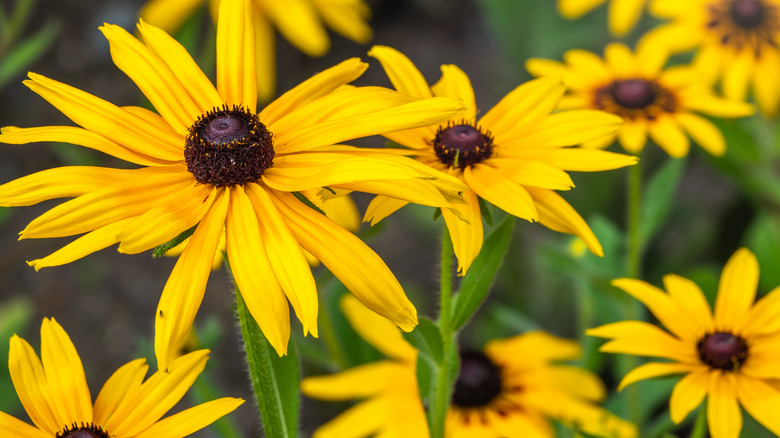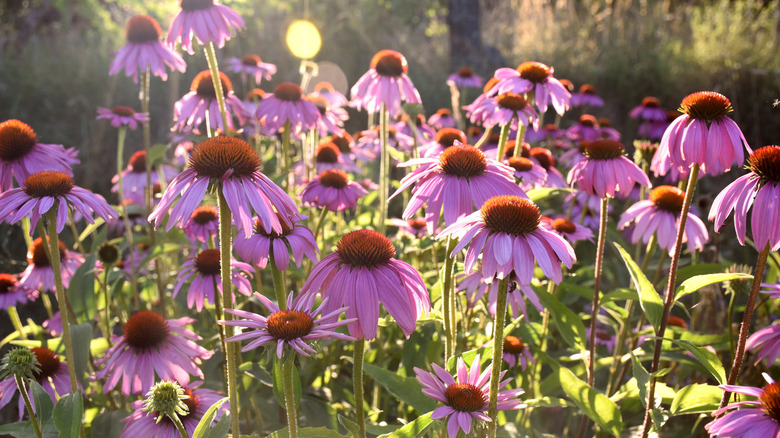How To Care For A Purple Coneflower
Purple coneflowers, known botanically as echinacea purpurea, are a member of the echinacea genus in the asteraceae, or daisy, family. According to The Spruce, this purple flower is one of, if not the most, popular members of the genus. The northeastern American native flower somewhat resembles a purple daisy in shape, although the pistil is raised and more conical in shape — hence the name coneflower.
The delicate, light purple, almost magenta-colored petals splay out around the dark yellow-brown center and can grow anywhere from 2 to 5 feet tall. Purple coneflowers grow as perennials in most moderate-tempered regions of the United States. They are also popular among pollinator gardeners, as they are a favorite of bees, butterflies, hummingbirds, and finches.
Purple coneflowers bloom in the summer and are native to prairie environments. They aren't finicky flowers, but a little bit of extra TLC can result in some truly gorgeous blooms. As a bonus, they're nontoxic to humans, pets, and wildlife (via Plant Addicts).
How to use purple coneflower in garden
Before planting purple coneflowers in your backyard, you should make sure you have a suitable area to grow them in. This purple perennial grows best in most of the United States, specifically in USDA hardiness zones 3 through 8, as per The Spruce. The only climates it has issues with are consistently wet or extremely humid and hot ones. It does best in areas that receive six to eight hours of full sun and tends to droop in shadier areas.
Coneflowers grow tall and thin and look great among other flowers or foliage as borders or in fields. Since coneflowers are naturally found in prairies, also consider planting them in vast meadows or open spaces. They are also great flowers for pollination gardens, especially when planted among other pollinator-friendly flowers. Backyard Garden Lover recommends a handful of beneficial and beautiful companion plants, including fellow pollinator attractors like stachys, stonecrop, coral bells, salvia, bee balm, butterfly milkweed, and phlox. In terms of practicality, consider bordering your coneflowers with black-eyed Susans, which not only attract pollinators but are deer resistant. Catmint is another great (and edible) option, as it naturally repels harmful pests like aphids and squash bugs.
How to grow purple coneflower
There are a few different options for planting beautiful purple coneflowers in your backyard or flower bed. One way is to visit a gardening center during the start to middle of the growing season (late spring to early summer) and look for pre-grown flowers, which you can easily plant in your yard. You can also plant them in the spring from rhizomes, which are often marketed as bulbs (via Garden Guides). These will be found in stores before the start of the growing season, roughly late winter to early spring, and should be planted after the last threat of frost.
You can also grow purple coneflowers from seeds or root division, Gardening Know How advises. Seeds can be found in stores or from online retailers, or harvested from an existing flower. Be quick when harvesting seeds, as birds tend to eat them up. Once the flower starts to die and dry out, put a paper bag over the seed head and shake out some seeds. Chill them in your fridge for a few weeks, and plant them in late fall or early spring.
Root division can be done to mature plants every three to four years. Do so by carefully digging the plant up and separating it into different plants by cutting the roots with clean, sharp shears. Simply replant the different roots back in the ground.
How to care for purple coneflower
According to The Spruce, mature coneflowers are quite easy to take care of, as they are rugged and hardy flowers. The outlet only notes that young flowers in their first year of growth may need a little more care, such as mulching them during the first winter.
In terms of routine care for mature coneflowers, make sure to provide them with plenty of light. While they can survive in shadier conditions, the flowers will likely be faded, and the plant will probably start to flop at the stem. They will do best with six to eight hours of full sun. Similarly, they are drought-tolerant, but won't thrive as much with a limited water supply. Plants under a year old should be watered an inch per week, but older plants should receive enough water from rainfall, with supplemental waterings during dry spells.
Purple coneflowers love rich soil with lots of organic matter, but be careful not to overdo it, as they will start to become quite leggy. Adding some compost at the beginning of the spring once a year should be enough. They can do well in most soils, with a preference for neutral pH levels (6.5 to 7.0) and a strong dislike for consistently wet soil.
Purple coneflower varieties
Purple coneflowers are just one (albeit very popular) species in the large echinacea genus, which includes true species variations, as well as synthetically bred hybrid species, all of which offer a stunning array of colors, sizes, scents, growing conditions, and more. Here are just a few, per The Spruce:
-
Echinacea 'Tomato Soup' — This species gets its hybrid nickname from its creamy red, tomato soup-like petal color. It blooms from June to August and reaches up to 3 feet tall and 5 inches in diameter.
-
Echinacea purpurea 'Doubledecker' — This variety is actually a hybrid of the standard purple coneflower, and is named for the second flower that grows from its seed head.
-
Echinacea 'Flame Thrower' — Created in 2009, this early-blooming variety has bright, golden yellow petals and a dark red pistil, making it a truly unique addition to your garden.
-
Echinacea x purpurea 'Balscanery' — This flower is known as Double Scoop Cranberry due to the appearance of the flower, which looks like a heaping scoop of cranberry ice cream.
-
Echinacea purpurea 'Avalanche' — This white petaled variety of purple coneflower strongly resembles a shasta daisy, but is far more hardy.
How to repot purple coneflower
While purple coneflowers are known for being easy-to-grow, in-ground perennials, that doesn't mean they can't stand out in a container or pot. Potted coneflowers need a slightly different care routine, though, including more frequent fertilization and deadheading, different watering routines, and, most importantly, occasional repotting.
Almanac recommends repotting purple coneflowers once every three to four years, which gives you the opportunity to divide and repot the new growth (which could otherwise overcrowd and subsequently smother the mother plant), as well as refresh the soil and add new nutrients.
To repot purple coneflowers, begin by gently removing the flower from its current pot. This can be done by laying the pot on its side and carefully tugging it out, or using a spade. Remove the dirt from its roots and check for signs of disease, infestation, mold, rot, etc., and discard any affected roots. Then, use clean and sharp garden shears to separate the roots to your liking. Repot at the same level the roots were previously sitting at with any well-draining, neutral pH soil.
